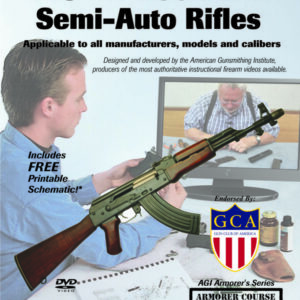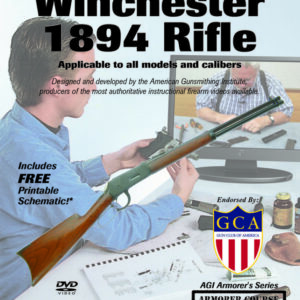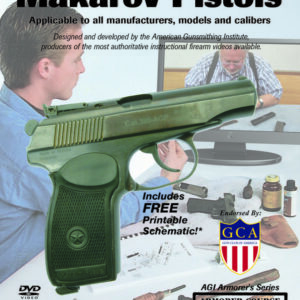Description
Models 1889, 1890, 1891, 1892, 1893, 1894, 1895, 1896, and 1898 Mausers from two World Wars, countless smaller wars, and dozens of country’s arsenals are back on the market in many variations. Applicable to all models and later variations. Highly detailed, Ken shows you multiple models and explains their differences. This is the most widely used, highly respected, and prolific bolt-action battle rifle ever made. In 1889, Paul Mauser began the development of his front locking military bolt actions to the near perfect model ’98. The rapid adoption by the Imperial German Army a century ago, through the present day. In addition, the ’98 and its variations have been in combat somewhere in the world in every decade. Complete instructions for disassembly to the last screws and pins, inspection, cleaning, and reassembly will make you an expert on the care of these guns.
This course is designed to help all of you owners who love the gun, but are a little mystified about its workings. In true AGI fashion, we use a custom cut-a way gun that allows you to see how the various parts work and interact.
If you want the quick course on how to get this timeless, classic, bolt action rifle apart, back together, and operating as intended, then this course is for you (if you want the long course, look into our basic 108 hour Professional Gunsmith Course.)
Among the items covered are:
History
- Peter Paul Mauser and his brother Wilhelm were the youngest of 13 children, and their father was a Master Gunsmith at the German Imperial Firearms factory at Oberndorf. Several of their brothers worked there as well
- One of the Mauser brothers immigrated to America and went to work for Remington
- First Mauser turn bolt design was in 1866 and was a variation on the American Dreyse Needle Gun design
- First success was the model 1871, adopted by the German Army in that year
- Wilhelm and Peter Paul (Paul) Mauser founded their own company. Paul was the genius designer and Wilhelm was the bookkeeper and salesman
- Wilhelm died in 1882
- In 1888, the Commission rifle was adopted by the German Army. It was not a Mauser design but had two forward, 180 degree opposed, locking lugs, an idea that Paul would adopt the next year in the 1889, the first of the modern Mausers, and the forerunner of the 1891
- Belgium adopted the 1889
- One of Mausers greatest ideas was the stripper clip
- 1889-1891 give a ways are the external magazine and what is now called a Sako style extractor
- All models through 1896 cock on closing
- From 1893 and on, they have the full-length claw extractor and controlled round feeding
- Paul Mauser always included the best features from his previous guns in his evolutionary newer models
- The 1898 was his perfected bolt gun
- Paul Mauser died in 1913, but the company continued on
- .22LR military training rifles were made both before and between the wars
- Mauser collecting really started in the 1950s. Ken tells you how to tell an original gun
- If you have an original, do not cut it up and sporterize it, sell it to a collector, and buy a parts gun for sporterizing
- Mauser collectors books shown
Design & Function
- Feeding cycle shown and the function of the extractor and ejector explained and demonstrated as well
- Trigger operation demonstrated, along with an extreme close up and explanation of the two-stage system
- Bolt lock-up, via camming surfaces in the lug recesses at the rear of the chamber area shown
- How the bolt sleeve lock is released to allow the bolt to rotate shut
- The bolt sleeve lock notch is also used by the safety when the bolt is closed
- Safety operation shown and described
- Why the bottom of the cocking piece has a relief machined for the sear
- Firing pin and cocking mechanics, operation of the firing pin safety flange shown and described
- Cock on opening system of the 98 demonstrated
- Cock on closing system of the 89 through 96 guns shown and explained in detail
- Magazine function, what holds the floor plate in, and how the release latch works
Disassembly of the Mauser 1898
- Extensive disassembly and instructions on how to take apart those parts/assemblies not disassembled, such as the firing pin disassembly disk, recoil lug, and front sight
- Barrel bands and upper hand guard removal shown
- Removing the action assembly and magazine, what to be aware of when removing a the trigger guard assembly
- Buttplate and bayonet lug removal
- Magazine box disassembled from trigger guard, and spring removal from floor plate and follower shown
- Floor plate retaining plunger removal shown
- Bolt stop assembly removed and disassembled
- Trigger disassembly shown
- Barrel assembly disassembly begins
- Front sight disassembly described
- Rear sight removal shown and described
- VZ-24 rear sight differences shown
- Bolt disassembled
- Firing pin and bolt sleeve assembly removed
- Extractor and collar removed
- Military firing pin disassembly aids shown
- Reason for machined flats on firing pin discussed
- You get a good look at how the various parts fit together and interact (particularly the springs) after they are removed from the gun and Ken explains things
Cleaning & Lubrication
- AGI cleaning & lubrication methods shown, along with the reasons for their use
- After cleaning, dry with air gun, or in the oven on Warm ~185-200 degrees (metal parts ONLY)
- Lubing the Bob & Ken way, and what kind they like
Disassembly of the Mauser 1889 thru 1892
- The bolt is disassembled, including bolt sleeve, cocking piece, safety, and extractor
- Magazine disassembly is shown with close-up detail
- Trigger guard disassembly follows, including magazine catch
- Bolt stop is removed and disassembled
- Trigger disassembled and minor difference between it and a model 98 is noted
- Reverse order reassembly
- Alternate magazine model retention and removal shown in reference book
- Bolt reassembly
Disassembly of the Mauser 1893 thru 1896
- Differences and variations, such as bolt face, extractor removal, bolt sleeve and cocking piece removal
- What is that hole doing in the left side of my 93 receiver ring
- Firing pin removal
- Trigger safety notch operation
- Model 1895 rear sight disassembly
- Model 1896 rear sight disassembly
Reassembly
- Bolt reassembly, including bolt sleeve, bolt sleeve lock, cocking piece, firing pin and spring, and extractor
- Bolt stop reassembled
- Magazine and trigger guard reassembled
- Trigger reassembled
- Rear sight reassembly shown, both K-98 and VZ-24
- Trigger assembly installed
- Ejector/bolt, stop assembly reinstalled
- Stock reassembled
- Barreled action installed in stock
- Trigger guard and magazine floor plate and follower reinstalled
- Final assembly, hand guard and barrel bands
- Testing
Accessories and Collectables
- Books and manuals
- Original German military ammo
- J bore and S bor




